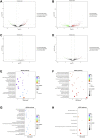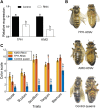Feeding Asian honeybee queens with European honeybee royal jelly alters body color and expression of related coding and non-coding RNAs
- PMID: 36776963
- PMCID: PMC9908965
- DOI: 10.3389/fphys.2023.1073625
Feeding Asian honeybee queens with European honeybee royal jelly alters body color and expression of related coding and non-coding RNAs
Abstract
Background and aims: The Asian honeybee (Apis cerana) and the European honeybee (Apis mellifera) are reproductively isolated. Previous studies reported that exchanging the larval food between the two species, known as nutritional crossbreeding, resulted in obvious changes in morphology, physiology and behavior. This study explored the molecular mechanisms underlying the honeybee nutritional crossbreeding. Methods: This study used full nutritional crossbreeding technology to rear A. cerana queens by feeding them with an A. mellifera royal jelly-based diet in an incubator. The body color and the expression of certain genes, microRNA, lncRNA, and circRNA among nutritional crossbred A. cerana queens (NQ), and control A. cerana queens (CQ) were compared. The biological functions of two target genes, TPH1 and KMO, were verified using RNA interference. Results: Our results showed that the NQ's body color turned yellow compared to the black control queens. Whole transcriptome sequencing results showed that a total of 1484, 311, 92, and 169 DEGs, DElncRNAs, DEmiRNAs, and DEcircRNAs, respectively, were identified in NQ and CQ, in which seven DEGs were enriched for three key pathways (tryptophan, tyrosine, and dopamine) involved in melanin synthesis. Interestingly, eight DElncRNAs and three DEmiRNAs were enriched into the key pathways regulating the above key DEGs. No circRNAs were enriched into these key pathways. Knocking down two key genes (KMO and TPH1) resulted in altered body color, suggesting that feeding NQ's an RNAi-based diet significantly downregulated the expression of TPH1 and KMO in 4-day-old larvae, which confirmed the function of key DEGs in the regulation of honeybee body color. Conclusion: These findings reveal that the larval diets from A. mellifera could change the body color of A. cerana, perhaps by altering the expression of non-coding RNAs and related key genes. This study serves as a model of epigenetic regulation in insect body color induced by environmental factors.
Keywords: body color alteration; gene expression; honeybees; non-coding RNA expression; nutritional crossbreed.
Copyright © 2023 Abdelmawla, Yang, Li, Li, Li, Liu, He and Zeng.
Conflict of interest statement
The authors declare that the research was conducted in the absence of any commercial or financial relationships that could be construed as a potential conflict of interest.
Figures




Similar articles
-
Roles of DNA Methylation in Color Alternation of Eastern Honey Bees (Apis cerana) Induced by the Royal Jelly of Western Honey Bees (Apis mellifera).Int J Mol Sci. 2024 Mar 16;25(6):3368. doi: 10.3390/ijms25063368. Int J Mol Sci. 2024. PMID: 38542342 Free PMC article.
-
Systematic identification of circular RNAs and corresponding regulatory networks unveil their potential roles in the midguts of eastern honeybee workers.Appl Microbiol Biotechnol. 2020 Jan;104(1):257-276. doi: 10.1007/s00253-019-10159-9. Epub 2019 Nov 21. Appl Microbiol Biotechnol. 2020. PMID: 31754765
-
Transcriptome differences in the hypopharyngeal gland between Western Honeybees (Apis mellifera) and Eastern Honeybees (Apis cerana).BMC Genomics. 2014 Aug 30;15(1):744. doi: 10.1186/1471-2164-15-744. BMC Genomics. 2014. PMID: 25174638 Free PMC article.
-
Origin and function of the major royal jelly proteins of the honeybee (Apis mellifera) as members of the yellow gene family.Biol Rev Camb Philos Soc. 2014 May;89(2):255-69. doi: 10.1111/brv.12052. Epub 2013 Jul 16. Biol Rev Camb Philos Soc. 2014. PMID: 23855350 Review.
-
Meta-analysis of transcriptomics data identifies potential biomarkers and their associated regulatory networks in gallbladder cancer.Gastroenterol Hepatol Bed Bench. 2022;15(4):311-325. doi: 10.22037/ghfbb.v15i4.2292. Gastroenterol Hepatol Bed Bench. 2022. PMID: 36762219 Free PMC article. Review.
Cited by
-
Roles of DNA Methylation in Color Alternation of Eastern Honey Bees (Apis cerana) Induced by the Royal Jelly of Western Honey Bees (Apis mellifera).Int J Mol Sci. 2024 Mar 16;25(6):3368. doi: 10.3390/ijms25063368. Int J Mol Sci. 2024. PMID: 38542342 Free PMC article.
-
Epigenetic Mechanisms in Apis melifera: From Development to Environmental Adaptation.Curr Issues Mol Biol. 2025 Jul 17;47(7):554. doi: 10.3390/cimb47070554. Curr Issues Mol Biol. 2025. PMID: 40729023 Free PMC article. Review.
-
Role Analysis of the scarb1 Gene in the Pigmentation of Neocaridina denticulata sinensis.Animals (Basel). 2025 Mar 21;15(7):901. doi: 10.3390/ani15070901. Animals (Basel). 2025. PMID: 40218295 Free PMC article.
References
-
- Arakane Y., Noh M. Y., Asano T., Kramer J., K. (2016). “Tyrosine metabolism for insect cuticle pigmentation and sclerotization,” in Extracellular composite matrices in arthropods. Editors Cohen E., Moussian B. (Switzerland, 156–220. 10.1007/978-3-319-40740-1_6 - DOI
-
- Chen H., Li F. M., Zheng M. J., Cao D. D., He Z. M., Yang M. X. (2015). The effect of nutritional hybridization on the reproductive potential of the queen bee in China. Sichuan Anim. Husb. Vet. Med. 42 (09), 24–26. (in Chinese).
LinkOut - more resources
Full Text Sources

